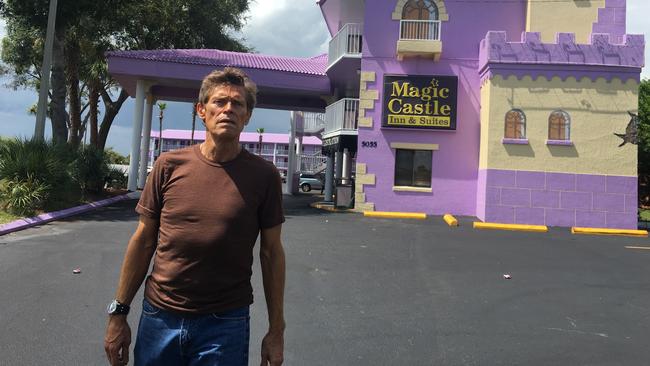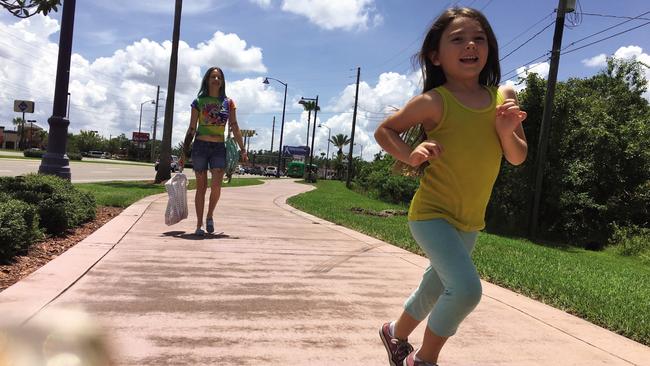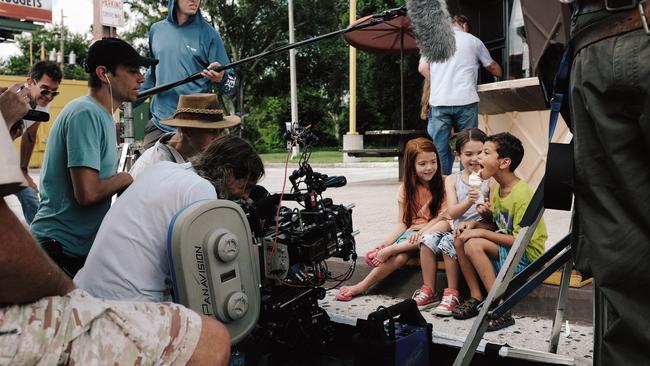The Florida Project: coming out of the shadows
Willem Dafoe and Sean Baker talk about the motivations behind The Florida Project.

Sean Baker’s The Florida Project is singular, beautiful and heartbreaking. It’s the kind of movie Willem Dafoe is drawn to: a film that provides an exhilarating environment for an actor who likes to work in different kinds of situations.
With a cast almost entirely made up of non-professionals and a lead actress who is six years old, The Florida Project provided intriguing challenges and opportunities. “Nobody is considering it as a job,” Dafoe says, referring to most of his fellow cast members, even if they are utterly engaged in the process. “They’re doing this thing, they’re having a life, now, in this structured fiction,” he says. “So in many ways, they’re free.”
As an actor, he’s looking for a certain kind of freedom himself. “I always enjoy trying to figure it out, and being in a place where you don’t know what it is. There’s no nailing it, there’s no getting there. The process is about going towards something.”
The Florida Project has already won many admirers: it is on critics’ best-of lists and there is speculation about awards. Dafoe’s delicately observed, disarming performance has led to nominations for the Golden Globes and the Screen Actors Guild Awards, and the movie is drawing plenty of Oscar talk.

It focuses on the world of a handful of children, above all a bright, inquisitive six-year-old called Moonee, played with wonderful aplomb by Brooklynn Prince. Moonee leads a precarious existence with her young mother, Halley (Bria Vinaite), in a motel called the Magic Castle, in the shadow of Disney World. In the face of uncertainty and volatility, she and her friends have a strong imaginative life and a resourceful way of dealing with the world, even at the darkest moments.
Baker’s co-writer, Chris Bergoch, became aware of the phenomenon of “the hidden homeless”: families, usually headed by a single mother, living week to week in cheap motels, struggling to get by. The film could be set anywhere in America, Baker says, but Bergoch encountered the issue in Florida while he was visiting his family.
There was also something about the motels in the region — brightly coloured and poignantly presented, modelling themselves on the Disney World dreamscapes next door — that made them ideal, resonant locations.
The Florida Project’s setting, the Magic Castle, is a genuine working motel, and it stayed that way while the film was shot. Baker and his small crew manoeuvred around its daily routines, occasionally incorporating things that happened and people from the motel into the life of the movie. The magnificently mauve Magic Castle also gave the production designer — Baker’s sister, Stephonik Youth — a rich foundation to work with.
The motel is presided over by Bobby (Dafoe), a manager with a desire to do things the right way and a sense of responsibility for his tenants, however difficult they might be.
Dafoe prepared for his role carefully, meeting former managers and finding a wardrobe for his character, but many of the important aspects of the performance, he says, evolved during production.
He’s not a great believer in creating a backstory for the characters he plays. “I’m a firm believer that the heart of performance is in presence, in being there, in listening and receiving. When you get involved too much in backstory you create an obligation to pay off things and to show things, and I think you get in trouble then because you’re cheating your intuition and your flexibility.”
Bobby is defined by his tasks as much as anything else. “The story is not about Bobby, it’s about this place and my role in the place, to keep the peace and take care of things, and that’s really what I concentrated on.
“Every day at the Magic Castle, since it was a working place, I would learn things, I would hear people’s stories, it was an education.”
Being there with his fellow performers was the key to what he did with this. “When you’re working in a real place like that, with a non-traditional cast of people who have nothing to compare the experience to, you’re all in, and stuff happens. And it’s kind of a cliche but it’s true, you become a little family. It creates a world. We created our own reality in the making of the film, and that informs the film itself.
“I got close with those kids, but I also had to wrangle them, just like in the movie. It was being a parent, you know, you had to go with it.
“I guess my point is that the relationships we had on the set really informed the movie and vice versa.”
Dafoe and Baker are adamant that Prince is a performer with a future. Baker says he knew she was exactly what he wanted for the role, she had “wit and energy and sensitivity”, but he was still unprepared for the emotion — “she was completely in character” — that she brought to a key scene at the end of the film.
She came with some experience: she had done a few commercials and knew her way around a set. The other young actors, however, were newcomers.
The Florida Project has the air of a film that eavesdrops on its subjects’ lives; there’s a fresh, provisional quality about events and circumstances. It was carefully scripted, Baker says, but there were a few scenes that explicitly left a space for play, or room to go with the moment.
Things also happened by chance: there’s a lovely scene involving a flock of birds wandering into the motel forecourt that was captured on the fly, improvised by Dafoe and the movie’s Steadicam operator.
Having a script, Baker says, was important for his young cast. “They had lines to rehearse and that helped them to understand their character and their situation.
“And if I asked them to improvise they would have a foundation.”
He says he had trouble casting the role of the mother: he found Vinaite not long before shooting started, via her Instagram account. She had no acting experience, but she had the qualities he was looking for — a certain vividness and a sense of humour — and he became convinced that she could bring them to the screen. She also had to explore some raw, volatile emotions, in scenes in which the embattled Halley loses control.
For Dafoe, Vinaite “was the real deal, she understood what she needed to do, she was so present and she inhabited that character. She’s not that person but she has had some parallel experiences, and that allowed her to imagine being that person.”
Working with non-actors highlights something that seasoned actors often wrestle with, he says. “Actors have to constantly fight corruption, and when I say corruption I mean getting limited in their impulses, deciding on something and getting rigid, or having too much need for something, or wanting things to be a certain way too badly, or trying to control things too much.”

Non-actors haven’t learned those habits. “They’re slow to develop a kind of schtick, it takes a little while, so in a case like this, it was never that Bria all of a sudden thought she was a diva. She was cool, it was an adventure to her, as it should be. And I’m trying always to do that in performing, but it’s tough.
“My favourite performances are the ones when you think, ‘they aren’t really actors, they’re just people’. You know, the Harry Dean Stantons of the world.”
During production, Baker and Bergoch wrote a couple of extra scenes for Bobby. They had thought they might introduce a brother into the story, but realised that the implication of a parent-child relationship would work better. So, on a couple of occasions, Bobby’s son turns up, helping with maintenance.
For Dafoe, these awkward, fleeting moments were another example of the way the filmmaking worked on The Florida Project.
“I think they’re very beautiful scenes; they aren’t very explicit and you don’t even know for sure that’s his son, but the writing is very good and the actions are clear: it doesn’t nail things down but it sort of places Bobby,” he says. “You know he’s had some disappointments in his life, you know that he’s struggling too.”
Baker knew exactly who he wanted to play the newly created role. Several years ago, he had seen Caleb Landry Jones in Brandon Cronenberg’s austere dream of celebrity obsession, Antiviral, and said to himself, ‘One day someone will cast him as Willem Dafoe’s son, they look so alike.’ ” They were able to make contact via filmmakers they knew, and Jones was soon on set in the role Baker had predicted for him.
One thing they weren’t ready for was the introduction of a helicopter port next door. They were too close to production to consider moving, so they had to find a way of living with the helicopters and the challenges their presence posed to location sound and performance.
“We had to make the helicopter a character in the film, to make the most of it.” Baker says. This included thinking of them as part of the “flyover” culture of people coming in and out of the area; tantalising the audience with the prospect of escape; and providing moments of tension
Even the intrusive sound could be incorporated into the fabric of the movie. “I didn’t want any music in this film [although there’s a strategic use of Kool and the Gang’s Celebration] but I still needed to fill up the ambience,” Baker says. “It gave me a wall of sound.”
Another interesting constraint: The Florida Project was shot on film. Baker’s previous movie, Tangerine, was famously shot on iPhones and, although he’s more than happy with the options this gave him, he doesn’t want to be known as “the iPhone guy”. He hadn’t shot on film since his first feature, and wanted to return to the format: this seemed the right time for it. “I really wanted to capture that environment in a way that was clear and clean, and the organic quality of the photochemical process, it’s something I feel can’t be replicated.”
Apart from the beauty it offered him, he liked the idea of helping to keep the format alive. “It’s important, I think. I recognise it, as I think all filmmakers should, as the medium that created this art — we’re too easily letting it go.”
Film also imposes a useful discipline on the set. “People take every single take very seriously, and that can definitely be applied to the children. You say to the kids, ‘Hey kids, you hear that sound? That’s the film going through the gate, that’s money burning right now, you guys have to focus’, and they did, and it worked. I think 35mm and kids made it easier than digital.”
There’s nothing didactic about The Florida Project, but Baker would like to think it will encourage audiences to think about the people whose lives it draws on — the phenomenon of the hidden homeless. At Q & A screenings, he says, “What we always stress is, ‘Look into it in your own community, it might be right under your nose and you don’t know it.’ ” Once they recognise it, he says, people want to know what they can do about it. “Awareness and education is the first step towards change.”
The Florida Project is screening nationally.


